Today, supercross is huge. A nationwide series of 17 races draws tens of thousands of fans almost every Saturday night from January through May, and the racers are rock stars earning millions of dollars per year. So lucrative is indoor racing that some top riders don't even bother to compete in the outdoor nationals anymore.
But in 1972, motocross was a relatively new sport that was exploding in popularity in the wake of Bruce Brown's epic film, On Any Sunday. Into this scenario came a bold experiment: bringing motocross into a stadium. The inaugural Superbowl of Motocross at the Los Angeles Coliseum would not only have lasting repercussions, but had perhaps the greatest fairytale ending of any race in the sport's history.
In 1967, in an effort to promote motocross racing in the U.S., Husqvarna importer Edison Dye created the Inter-Am Series to lure the top European talent to America during the off-season. This was a time of complete and utter European domination.
Against this backdrop, a young kid from Santee, California, had perhaps the greatest day any motocross fan could ever ask for. Racing locally in one of the first Inter-Am events, the European stars found their way to Marty Tripes' house for dinner.
"The Europeans didn't like the food here very much, so my dad invited all these guys over to my house for my mom's home-cooked dinner," Tripes recalls. "Here I was, 11 years old, with the world's top motocross riders in my backyard! I remember asking [250cc World Champion] Joel Robert how to ride down the big downhill at Saddleback Park." That evening certainly made an impression on the young American, and he dedicated himself to becoming the best motocross racer he could. Soon, he was to experience European motocross firsthand.
"I learned a lot the first time I went to Europe," Tripes continues. "It was a national race in Prague, Czechoslovakia, and I rode a 250 for the first time. The uphills were so steep that there were ropes so the spectators could get up them. I didn't know the course was that bad until I got to the first uphill--I was scared to death! The finish line was about a 50-foot drop-off. I closed my eyes and went off it. That was a real motocross track. [After that] when I practiced I would use the hardest, roughest track I could make. I'd be practicing with Tommy Croft and he'd say, 'How do you ride on stuff like this?' I'd lap him every few laps. I'd tell him this is what they do in Europe."
As a local racer, Tripes was a front-runner on everything he rode, from his 100cc Penton Berkshire to a succession of CZs. Larger than average, Marty came to be known as "The Big Kid on the CZ" as he quickly moved up through the classes while still in high school. By '71 he had a ride with Montesa, and had won the Mammoth Mountain Motocross. But there was a minimum age to race professional motocross, and Marty wouldn't turn 16 for another year.
Meanwhile, the AMA put together its own Trans-AMA Series, which put the Inter-Am out of business after a one-year struggle. But as an investment in the sport, the Inter-Am had succeeded beyond Dye's wildest dreams. His motocross business, Husqvarna West, was growing exponentially, and at the end of '71 he went looking for a general manager. He hired legendary flat-track racer Everett Brashear, who was instrumental in founding the Husqvarna Motocross School at Carlsbad with World Champion Rolf Tibblin of Sweden.
Every dream starts with a crazy idea, and supercross was no exception. One day promoter Mike Goodwin called Everett to ask if he could talk to Tibblin about building a motocross track in the L.A. Coliseum. Everett told him he was crazy, but Tibblin was intrigued with the idea. "We can make it look good," he said. "It won't be a motocross track, but it will work."
Word soon spread that the inaugural Superbowl of Motocross was going to be held on the playing field of the Los Angeles Rams, and the 1932 (and future) home of the Olympic Games. But the announcement was greeted by skepticism: A motocross track being configured on the floor of a stadium seemed a physical impossibility. It also seemed unlikely that a non-points-paying race would pull many Europeans from their primary task in the middle of the Grand Prix season. Regardless, the Southern California motocross community circled July 8, 1972, on their calendars and hoped for the best.
In the meantime, Tripes had landed a factory ride with Don Jones' Team Yamaha the weekend after his 16th birthday. His first race as a professional rider in Washington resulted in a mid-pack finish, but in his second race Marty would make history.
The anticipation of seeing the European stars race in a stadium had the SoCal locals excited beyond words. At 17, I took my first trip from San Diego to Los Angeles to view the race, arriving at the venue just before the gate dropped for the first heat. Thousands of yards of dirt had been placed over the manicured turf, and haybales lined the course. One of the first events with a title sponsor, the Yamaha International Cup used a three-moto format for the headlining 250cc and support 500cc classes. We San Diegoans hoped that our local hero Tripes would make a good showing, but none of us were prepared for what was to unfold that night.
A crowd of 30,000 had made its way to the event, well beyond the numbers at the recent Carlsbad USGP or Saddleback Trans-AMA races. And the Europeans came, too: Thorleif Hansen--one of the stars from the previous year's USGP--was in attendance, along with teammate Arne Kring on their Husqvarnas. Yamaha had Torsten Hallman (in one of his last professional rides) and Hakan Andersson, in addition to the Team Jones Americans: brothers Gary and DeWayne Jones, Tim Hart and Tripes. Kawasaki had John DeSoto alongside Brad Lackey.
Hansen held off the Yamaha contingent in the first heat, but in the second DeSoto charged into the lead, followed closely by Kring. The "Flyin' Hawaiian" led numerous laps before losing it in the whoops and doing a handstand over the handlebars, ending his evening. Scratch one of the few Americans who had a prayer of beating the Europeans.
Kring went on to a dominant moto win, followed by Hansen and Tripes. Surprisingly, with his 2-2 finishes, Tripes was now tied for the lead with Hansen's 1-3. The almost-unknown 16-year-old was actually in with a solid chance against the Europeans!
Maico-mounted American Tim Hart took the holeshot in moto three, but was quickly dispatched by Hansen. Hope replaced despair as Andersson moved past Hansen and motored into the distance. All eyes turned to the battle for second. Hansen was in trouble as Tripes was closing fast, finally catching and passing him for the result that would lock up the overall win. What had previously been Team Husqvarna domination, with both riders trading wins, had turned to the benefit of title sponsor Yamaha with a 1-2 finish in the finale. Fast and consistent Tripes, with his three second-place finishes, had defeated the Europeans to win the inaugural Superbowl of Motocross!
"When the gate dropped, the track was so funky and different, it threw everyone off," Tripes remembers. "The Europeans had such a hard time with it being such a narrow, confined, tight and twisty track. It just fit me, so I ran my own race. I was passing guys without even thinking about it. It didn't really hit me until I got home the next day. When I woke up and the trophy was on my dresser, I thought, 'Did it really happen?'"
In the near-four-decade history of supercross, there have been many phenomenal races with surprise endings. But none can compare to the upset result of that first-ever event. When James Stewart won the 2002 San Diego Supercross at the age of 16 to take his first professional win, many thought the feat was unprecedented. Imagine if Stewart had won the 250cc main event that day instead of the 125cc support class, and you have an idea of what Tripes accomplished. At 16 years and 3 weeks old, Tripes remains, to this day, the youngest winner in supercross history.












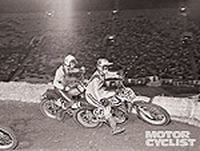
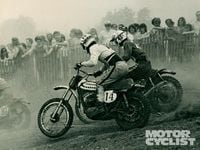




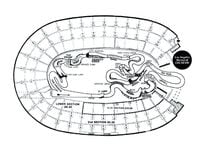


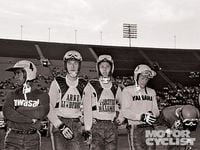
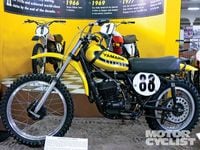

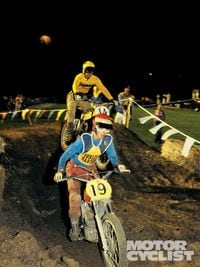
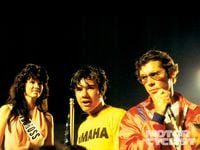
/cloudfront-us-east-1.images.arcpublishing.com/octane/3TIWWRV4JBBOLDVGRYECVVTA7Y.jpg)
/cloudfront-us-east-1.images.arcpublishing.com/octane/KIX5O23D5NAIBGFXBN3327DKZU.jpg)
/cloudfront-us-east-1.images.arcpublishing.com/octane/7GJYDUIPXRGMTMQKN6ONYOLBOU.jpg)
/cloudfront-us-east-1.images.arcpublishing.com/octane/MUQLOVLL2ZDGFH25ILABNBXKTI.jpg)
/cloudfront-us-east-1.images.arcpublishing.com/octane/TNOU5DNE2BC57MFPMGN2EIDXAM.jpg)
/cloudfront-us-east-1.images.arcpublishing.com/octane/GTCXACQGJ5HAPDTGWUQKDEH44E.jpg)
/cloudfront-us-east-1.images.arcpublishing.com/octane/S35YGSEMEZB4BLTDJTSZPF4GLA.jpg)
/cloudfront-us-east-1.images.arcpublishing.com/octane/5UOT6HPX2JFMRJAX6EH45AR4MQ.jpg)
/cloudfront-us-east-1.images.arcpublishing.com/octane/OKWOJWAKP5EP3OACCRRWPCIX2Q.jpg)
/cloudfront-us-east-1.images.arcpublishing.com/octane/2WF3SCE3NFBQXLDNJM7KMXA45E.jpg)
/cloudfront-us-east-1.images.arcpublishing.com/octane/G4MG6OUCJNBSHIS2MVVOTPX65E.jpg)
/cloudfront-us-east-1.images.arcpublishing.com/octane/IIGGWFOTOJGB7DB6DGBXCCMTDY.jpg)
/cloudfront-us-east-1.images.arcpublishing.com/octane/QSTCM6AVEZA5JJBUXNIQ3DSOF4.jpg)
/cloudfront-us-east-1.images.arcpublishing.com/octane/U4I7G625B5DMLF2DVIJDFZVV6M.jpg)
/cloudfront-us-east-1.images.arcpublishing.com/octane/B6XD6LS6IVCQPIU6HXDJSM3FHY.jpg)
/cloudfront-us-east-1.images.arcpublishing.com/octane/ICL63FEDDRDTTMINYICCEYGMDA.jpg)
/cloudfront-us-east-1.images.arcpublishing.com/octane/FCGZHQXRBZFLBAPC5SDIQLVF4I.jpg)
/cloudfront-us-east-1.images.arcpublishing.com/octane/WNOB6LDOIFFHJKPSVIWDYUGOPM.jpg)

/cloudfront-us-east-1.images.arcpublishing.com/octane/X33NU3E525ECRHXLNUJN2FTRKI.jpg)
/cloudfront-us-east-1.images.arcpublishing.com/octane/6KKT5NNL2JAVBOXMZYS5ZO76YA.jpg)
/cloudfront-us-east-1.images.arcpublishing.com/octane/J5RKG5O455GMPGQRF2OG6LRT7A.jpg)
/cloudfront-us-east-1.images.arcpublishing.com/octane/GX2CIZKQVRH2TATDM26KFG2DAE.jpg)
/cloudfront-us-east-1.images.arcpublishing.com/octane/ZWIDYSAKQZHD5BHREMQILXJCGM.jpg)